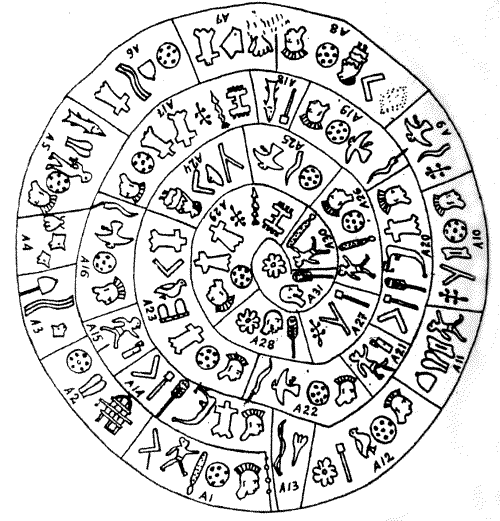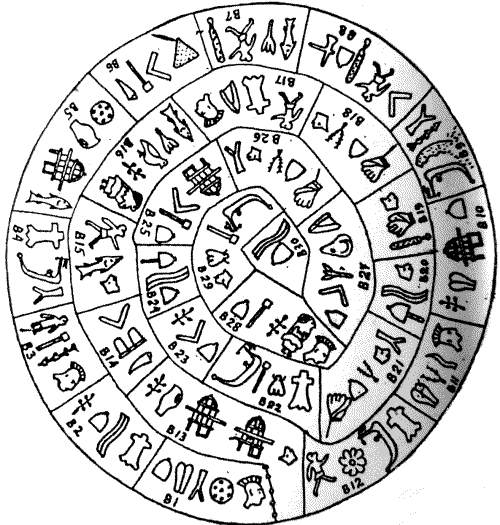THE TEXT ON THE PHAISTOS DISK


Part I
The form of Disk resembles the sun. And cf. halos "disk" and helios, halios "sun" in Greek.
Why the form of this text is a spiral? Cf. helix, helike and helios, heliake in Greek.
The sign No 2 (after Sir Arthur Evans’ numeration) is an image of the sun god, rather Phaistian Zeys Velkhanos (> Latin. Vulcanus), or Talos than simple Zeys. It is important that Zeys < Indo-European sun god (cf. Hittite-Luwian Tiw- "sun god"). Cf. also Greek images of Helios.
The sign No 12 = Linear A, B qe and the sign No 35 = Linear A, B te. These signs used in the same position (after G.Ipsen and W.Porzig). Cf. Mycenaean Greek qe and Classical Greek te.
So the language of the Phaistos Disk is some Greek dialect with qe / te alternation. (Cf. qe > te in Mycenaean Greek later than in other Greek dialects after I.M.Tronski and qe / te in Linear A).
The sign No 13 is a kyparissos after G.Ipsen (the root kypar-, cf. gofer in the Bible).
The sign No 1 is a "going man" (Greek ion, for example as a modern chemical term).
The sign group 13–1 (A1) = kypar(issos)–ion = Hyperion (cf. Pamphilian hypar = hyper, Linear B u–pa–r-). Probably Hyperion < Egyptian Hpr [heper] "morning sun" and hypar + ion is a popular etymology.
The sign group NoNo 24–40 (A2) = e–rjo (cf. Linear A, B e, Linear B rjo) = Helios.
So A1–2 Hyperion Helios = Hom. Hyperion Eelios (Il. VIII, 480; Od. I, 8).
The sign No 32 is a dove after Sir Arthur Evans. Cf. Greek phaps, Gen. phabos "dove" as a homonym for phabos = phaos "the light" (cf. Pamphilian phabos "light"; Cretan v > b as in Pamphilian). And cf. Phaistos < phaos (V.Georgiev’s etymology).
The sign No 23 is a nail. Cf. Greek helos "nail" as a homonym for Helios.
The sign group NoNo 32–23 (A12) = phaps–helos = phaos helioio "the light of the sun". Cf. Hom. phaos eelioio (Hymn. Hom. Eis Apollona I, 71 = Latin. fotus solis.
So the text on the Phaistos Disk is a Greek hymn to the sun god written as a rebus.